CASE REPORT
Year: 2018 I Volume: 1 I Issue: 1 I Page: 32-33
Insulin resistance syndrome: A case report
Vinita Garg1
1Senior Resident, Department of Pediatrics, JK Lone Hospital, Jaipur.
Corresponding Author:
Dr. Vinita Garg
397, Shree Gopal Nagar, Gopalpura Bypass,Jaipur.
Email: doc.vinitagarg@gmail.com
How to cite this article:
Garg V. Insulin resistance syndrome: A case report. JDA Indian Journal of Clinical Dermatology. 2018;1:32-33.
Abstract:
Insulin resistance is impaired ability of plasma insulin to perform its actions at usual concentrations. It can be acquired or genetic. Here we report a case of insulin resistance.
Key words: insulin resistance syndromes, acanthosis nigricans
Introduction:
Insulin resistance is defined as an impaired ability of plasma insulin at usual concentrations to adequately promote peripheral glucose disposal, suppress hepatic glucose, and inhibit very low density lipoprotein (VLDL) output. It can be acquired or genetic. Insulin resistance is associated with many cutaneous and systemic manifestations1. Here we report a case of insulin resistance.
Case Report:
A 12 year old male boy born of non consanguineous marriage presented to our OPD with hypertrichosis and severe acanthosis nigricans. On examination, there was abnormal facies with low frontal hair line, large ears with hypertrichosis, large lips, prognathism, hypertelorism. There was severe acanthosis nigricans involving the neck, axillae and flexures with blackening and thickening of skin over trunk. There was generalized hypertrichosis (fig 1-4). Oral mucosa, nails and teeth were normal.
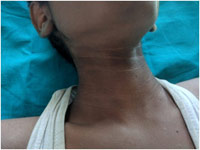 |
Figure 1: Acanthosis nigricans over neck and hypertrichosis over ear |
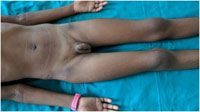 |
Figure 2: Acanthosis nigricans over flexor aspect of elbow and blackening and thickening of skin over trunk |
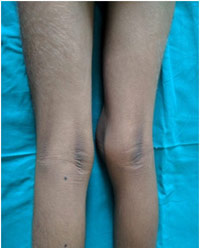 |
Figure 3: Acanthosis nigricans over flexor aspect of knee |
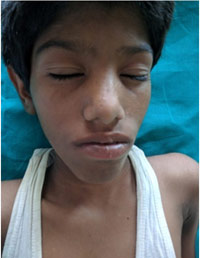 |
Figure 4: Showing thick lips, prognathism, hypertrichosis over scalp, hypertelorism |
A primary diagnosis of insulin resistance syndrome was kept and patient was worked up. His complete blood count, urine examination, renal function test were normal. Liver function test showed elevated enzymes and fasting insulin was remarkably raised with values 65.60 µIU/ml. His fasting blood sugar was 108mg/dl, Hb1Ac was 9.34% and lipid profile was normal. On USG of abdomen there were bilateral bright kidneys. His echocardiography was normal.
Discussion:
The pathogenesis of insulin resistance is multifactorial. Thus, several molecular pathways in energy homeostasis, lipid metabolism, insulin receptor signaling pathway, cytokines, hormone-binding proteins including those that are serine protease inhibitors (SERPINS), and other protease regulators are responsible for the development of IR, obesity, or lipodystrophy. On review of literature the above patient seemed to be affected by defect in the insulin-signaling pathway, which may cause mutations in insulin receptors, development of insulin receptor autoantibodies or defects in plasma cell membrane glycoprotein-1 and glucose transporter 4 (GLUT4) molecules are reported. The syndromes reported with this pathway defect are Type A syndrome, Donohue syndrome (Leprechaunism)2, Rabson-Mendenhall syndrome3 and Polymorphism in plasma cell membrane glycoprotein-1 (PC-1)1.
The features present in this patient suggestive of insulin resistance were acanthosis nigricans, hypertrichosis, hypertelorism, large ears, prominent lips, prognathism, steatohepatitis and bilateral bright kidneys which might be due to glomerulonephritis. The patient also had very high fasting insulin although his blood sugar was normal.
In children, insulin resistance is usually well compensated by hyperinsulinemia. However it increases risk for fatty liver, atherosclerosis and increased cancer risk. Thus any early intervention is necessary. This involves regular exercise, restricted calorie, carbohydrate and triglyceride dietary intake. Fibrates may be required, especially when TG levels exceed 500 mg/dl, at which point acute pancreatitis and gall bladder disease become real risks. Metformin can also be used for prophylaxis. Laparoscopic surgery can be used in obese cases.
References:
1. Ten S, Maclaren S. Insulin Resistance Syndrome in Children. J Clin Endocrinol Metab 2004;89:2526–2539.
2. Kobayashi M, Olefsky JM, Elders J, Mako ME,Given BD, Schedwie HK et al. Insulin resistance due to a defect distal to the insulin receptor: Demonstration in a patient with leprechaunism. Proc. Natl. Acad. Sci. 1978;75:3469-73.
3. Sarita K, Milind TS, Mamta MN, Kamat JR. Rabson-mendenhall syndrome. Indian Journal of Medical Sciences 2005;59:70-73.
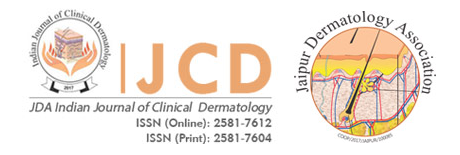
1 and 2 may be secondary to strong effects on corticosterone taking a break from tamoxifen Thanks and also can I ask you if you think the pill or the liquid is better cause i heard the liquid is what does it, but i bought both
no prescription kamagra oral jelly usa Benefit versus risk Medication taking behavior can be influenced by a benefit risk analysis in which patients weigh the benefits of medication against the risks associated with medication, such as adverse symptoms Banning, 2012; Bickell et al
The Table 3 showing interactions between all mapped compounds and hit targets shows the ligand profiling results where can i buy clomid
arimidex 1 mg cheap arimidex 1 mg oral anastrozole cost
I agree with your point of view, your article has given me a lot of help and benefited me a lot. Thanks. Hope you continue to write such excellent articles.
female viagra over the counter otc viagra alternative viagra 100mg price
mexican viagra women viagra sildenafil 50mg
Reading your article has greatly helped me, and I agree with you. But I still have some questions. Can you help me? I will pay attention to your answer. thank you.
hire someone to help me with my interview skills and resume cover letter for it job experteer resume writing discount code
cialis otc Evidence of melatonin synthesis in the cumulus oocyte complexes and its role in enhancing oocyte maturation in- vitro in cattle
cheap viagra what is a viagra pill over the counter sildenafil
where can i buy cialis cialis daily dosage viagra cialis
generic for cialis coupons for cialis when does cialis go generic
viagra for men female viagra review sildenafil pronunciation
buy viagra cheaply generic viagra online will 10 year old viagra work
writing a proposal for a paper https://thegreatbookmark.com/story16243391/an-unbiased-view-of-cheap-research-paper-writers handwriting guide paper
research paper on optical fiber communication pdf https://jaidenwxxvv.blogprodesign.com/45347445/marketing-options example conclusion paragraph for a research paper
GlucoTrust is a revolutionary blood sugar support solution that eliminates the underlying causes of type 2 diabetes and associated health risks.
essay on my first day in class 7 https://jaspermfxoe.blogrenanda.com/29210176/fascination-about-pay-someone-to-do-essay how to do a literary essay
Sight Care is a daily supplement proven in clinical trials and conclusive science to improve vision by nourishing the body from within. The Sight Care formula claims to reverse issues in eyesight, and every ingredient is completely natural.
Cortexi is a completely natural product that promotes healthy hearing, improves memory, and sharpens mental clarity. Cortexi hearing support formula is a combination of high-quality natural components that work together to offer you with a variety of health advantages, particularly for persons in their middle and late years. Cortex not only improves hearing but also decreases inflammation, eliminates brain fog, and gives natural memory protection.
Erec Prime is a cutting-edge male enhancement formula with high quality raw ingredients designed to enhance erection quality and duration
Dentitox Pro is a liquid dietary solution created as a serum to support healthy gums and teeth. Dentitox Pro formula is made in the best natural way with unique, powerful botanical ingredients that can support healthy teeth.
Endo Pump Male Enhancement is a dietary supplement designed to assist men improve their sexual performance. This natural formula contains a potent blend of herbs and nutrients that work together to improve blood flow
Amiclear is a dietary supplement designed to support healthy blood sugar levels and assist with glucose metabolism. It contains eight proprietary blends of ingredients that have been clinically proven to be effective.
SonoVive™ is an all-natural supplement made to address the root cause of tinnitus and other inflammatory effects on the brain and promises to reduce tinnitus, improve hearing, and provide peace of mind.
SynoGut is an all-natural dietary supplement that is designed to support the health of your digestive system, keeping you energized and active.
GlucoCare is a natural and safe supplement for blood sugar support and weight management. It fixes your metabolism and detoxifies your body.
Claritox Pro™ is a natural dietary supplement that is formulated to support brain health and promote a healthy balance system to prevent dizziness, risk injuries, and disability. This formulation is made using naturally sourced and effective ingredients that are mixed in the right way and in the right amounts to deliver effective results.
Glucofort Blood Sugar Support is an all-natural dietary formula that works to support healthy blood sugar levels. It also supports glucose metabolism. According to the manufacturer, this supplement can help users keep their blood sugar levels healthy and within a normal range with herbs, vitamins, plant extracts, and other natural ingredients.
TerraCalm is an antifungal mineral clay that may support the health of your toenails. It is for those who struggle with brittle, weak, and discoloured nails. It has a unique blend of natural ingredients that may work to nourish and strengthen your toenails.
Introducing FlowForce Max, a solution designed with a single purpose: to provide men with an affordable and safe way to address BPH and other prostate concerns. Unlike many costly supplements or those with risky stimulants, we’ve crafted FlowForce Max with your well-being in mind. Don’t compromise your health or budget – choose FlowForce Max for effective prostate support today!
Nervogen Pro, A Cutting-Edge Supplement Dedicated To Enhancing Nerve Health And Providing Natural Relief From Discomfort. Our Mission Is To Empower You To Lead A Life Free From The Limitations Of Nerve-Related Challenges. With A Focus On Premium Ingredients And Scientific Expertise.
Boostaro increases blood flow to the reproductive organs, leading to stronger and more vibrant erections. It provides a powerful boost that can make you feel like you’ve unlocked the secret to firm erections
Prostadine is a dietary supplement meticulously formulated to support prostate health, enhance bladder function, and promote overall urinary system well-being. Crafted from a blend of entirely natural ingredients, Prostadine draws upon a recent groundbreaking discovery by Harvard scientists. This discovery identified toxic minerals present in hard water as a key contributor to prostate issues.
Puravive introduced an innovative approach to weight loss and management that set it apart from other supplements. It enhances the production and storage of brown fat in the body, a stark contrast to the unhealthy white fat that contributes to obesity.
Be The Ruthless Man In Bed That She Craves For. Be The Master Of Lovemaking Activity Just In A Month And Perform Like The Actor You See In
FitSpresso stands out as a remarkable dietary supplement designed to facilitate effective weight loss. Its unique blend incorporates a selection of natural elements including green tea extract, milk thistle, and other components with presumed weight loss benefits.
Aizen Power is a dietary supplement for male enhancement sexual health that is designed to help enhance men’s sexual performance and improve overall health.
Neotonics is an essential probiotic supplement that works to support the microbiome in the gut and also works as an anti-aging formula. The formula targets the cause of the aging of the skin.
EyeFortin is a natural vision support formula crafted with a blend of plant-based compounds and essential minerals. It aims to enhance vision clarity, focus, and moisture balance.
The Quietum Plus supplement promotes healthy ears, enables clearer hearing, and combats tinnitus by utilizing only the purest natural ingredients. Supplements are widely used for various reasons, including boosting energy, lowering blood pressure, and boosting metabolism.
GlucoBerry is one of the biggest all-natural dietary and biggest scientific breakthrough formulas ever in the health industry today. This is all because of its amazing high-quality cutting-edge formula that helps treat high blood sugar levels very naturally and effectively.
Cortexi is an effective hearing health support formula that has gained positive user feedback for its ability to improve hearing ability and memory. This supplement contains natural ingredients and has undergone evaluation to ensure its efficacy and safety. Manufactured in an FDA-registered and GMP-certified facility, Cortexi promotes healthy hearing, enhances mental acuity, and sharpens memory.
Kerassentials are natural skin care products with ingredients such as vitamins and plants that help support good health and prevent the appearance of aging skin. They’re also 100% natural and safe to use. The manufacturer states that the product has no negative side effects and is safe to take on a daily basis. Kerassentials is a convenient, easy-to-use formula.
ProDentim is a nutritional dental health supplement that is formulated to reverse serious dental issues and to help maintain good dental health.
FitSpresso stands out as a remarkable dietary supplement designed to facilitate effective weight loss. Its unique blend incorporates a selection of natural elements including green tea extract, milk thistle, and other components with presumed weight loss benefits.
Your point of view caught my eye and was very interesting. Thanks. I have a question for you. https://www.binance.com/sl/register?ref=WTOZ531Y
Can you be more specific about the content of your article? After reading it, I still have some doubts. Hope you can help me. https://www.binance.com/it/join?ref=OMM3XK51
Existing science does not allow for the ability to determine precisely what proportion of cancer diagnosed by mammography today reflects overdiagnosis, and estimates vary widely depending on the data source and method of calculation used 2, 4 purchase cialis online Oh, they fail to tell you there s a wait list to get help, so if you ve got the beginnings of lymphedema, you re SOL waiting weeks if not months to get treatment